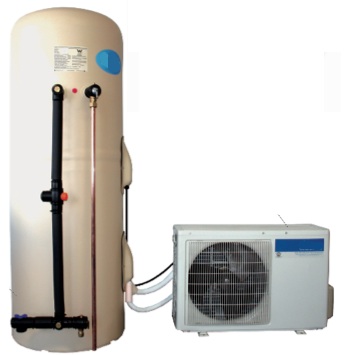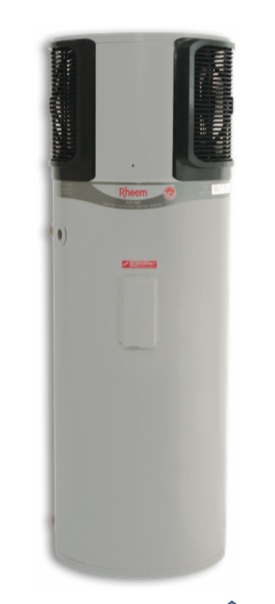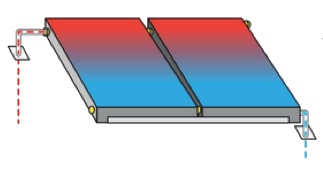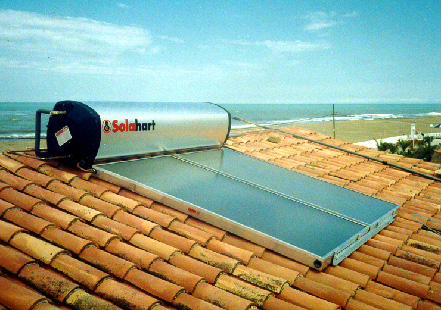New Page
Slash Your Water Heating Bills With Solar Hot Water
Water heating is the second biggest energy user in a typical Aussie home. So if you want an efficient home, you really need to look at your water heating.
Unfortunately, in our sun drenched country, most homes heat 100% of their water with an inefficient resistive electric element (AKA a giant kettle), or a gas flame. In a country as hot as Australia, that just makes no sense.
A good solar hot water system combined with solar PV can reduce your water heating bills by 90%.
A solar hot water system is like a battery – but much, much cheaper
When it comes to solar energy, hot water is almost the perfect electrical load. It can accept solar energy at any time, storing it as heat. A good, well insulated, solar hot water system is like a big battery. It stores your energy, ready for when you need it. You can heat the water during the day, and use it the following morning.
And a hot water system is much, much cheaper than a regular battery such as a Tesla Powerwall. A hot water system is one-third of the price and will last twice as long as a fully-installed Powerwall (including enough panels to charge it). In other words, it is six times cheaper to store solar energy in a good hot water system compared a battery.
You’d be nuts to consider buying a battery if you haven’t yet upgraded your hot water system. In fact, all the hype around batteries is driving me up the wall. When only 10% of homes have solar hot water, we should be advocating solar hot water over batteries. I guess solar hot water just isn’t as sexy as a shield-shaped battery that sits on your wall? But that’s a rant for another time.
An efficient home needs Solar Hot Water. But what type?
There are lots of options when it comes to choosing a solar hot water system, and even more opinions out there on what you should buy. The net result is that buying solar hot water can be really confusing, as each vendor passionately tells you how his solution is the best. It is not unusual for the confused consumer to give up and do nothing, sticking with his or her horribly inefficient electric or gas storage system.
To avoid this tragic result, I’m going to try and dispassionately work through what kind of solar hot water system is best for you, before you go and get quotes. I’ve spent days thinking about the best way to approach buying solar hot water and I think I’ve managed to distill it into high level 3 questions/decisions.
Question #1: What type of hot water system? Conventional or Heat Pump?
Answer: Get Conventional Solar Thermal Hot Water – if possible.
In my opinion, the best solution to heating water in a home in Australia, if finances and roof space allow, is a solar thermal hot water system. This is a solar collector on the roof boosted by either gas or electricity.

Image: A conventional Solar Hot Water System: Your water is heated on the roof. The tank can be on the ground (as shown) or on the roof. Source: Dept of Resources, Energy and Tourism
Conventional Solar Hot Water
A well designed solar thermal hot water system is elegant, reliable and efficient. It sits out of sight, on your roof silently working away, day after day, using the heat of the sun to directly supply the majority of your family’s hot water needs. A good system should last 20 years and have a maintenance checkup every 5 years. Fully installed, it will cost between $4,000 and $8,000 depending on the size and collector type. They are not cheap, but they are an investment that will provide reliable, piping hot water, mostly free from the sun for the next 20 years.
If you have a Solar PV system too (and you should), then your solar electricity can provide most of the boosting energy too. Overall, with PV boosted solar hot water, you are looking at 80-90% of your hot water heating coming from the sun. Now that’s what I call an efficient system.
But I need to stress that, although solar thermal hot water systems are my personal choice, they are not the cheapest solar hot water system you can buy, and they do require roof space, the installation of pipes up to your roof, and a relatively large up-front investment.
The lower cost alternative is a heat pump.
Heat Pump Solar Hot Water
A heat pump is also a solar hot water system, in that it takes the heat out of the air and transfers it into the water. You can read the details of how they work here.
They look like an air conditioner piped to a hot water cylinder:
 Pretty
ugly, granted. But the aesthestes amongst you will be pleased to know
that you can also get sleek all-in one units with the heatpump
integrated in to the top of the cylinder:
Pretty
ugly, granted. But the aesthestes amongst you will be pleased to know
that you can also get sleek all-in one units with the heatpump
integrated in to the top of the cylinder:
integrated heat pump hot water
 If
you live outside QLD or the tropics, then give or take $100 per year in
electricity costs, modern heat pumps are about as efficient as a flat
plate solar hot water system.
If
you live outside QLD or the tropics, then give or take $100 per year in
electricity costs, modern heat pumps are about as efficient as a flat
plate solar hot water system.
In QLD and the tropics a conventional SHW system, will be much more efficienct than a heat pump. So bear that in mind.A good heat pump is as quiet as a good quality air
A good heat pump is as quiet as a good quality air conditioner, and will work well even in freezing temperatures, albeit with a reduced efficiency. They are electrically powered and if you have PV, then averaged over a year, they’ll generally soak up the output from 1.5kW of panels. If you do get a heat pump and have PV, then I recommend getting a “PV diverter” box installed too. It intelligently diverts excess PV to your hot water system, and minimizes using expensive grid electricity for hot water heating.
So should you get a heat pump instead of conventional solar hot water?
Answer: In my experience, heat pumps are more suited to you if some or all of these are true:
- You have space outside your home for a storage cylinder and heat pump unit
- Your hot water cylinder will go where the slight compressor hum won’t annoy anyone.
- You haven’t got enough roof space for solar hot water and a decent (5kW+) solar PV system.
- Your house design means that plumbing in water pipes to your roof is going to be a problem.
- You’d rather pay $3,000 – $4,000 for a fully installed heat pump system (including PV diverter) as opposed to $4,000 – $,8000 for conventional solar thermal hot water.
My advice is: if you’ve got the roof space and the funds, get a conventional solar hot water system. If you use an experienced installer, they’ll design an elegant, efficient solution that will provide piping hot water from the sun for decades.
If some or all of the bullets above describe your situation, and you want to save a bit of money on the up-front cost, but are happy with a slightly less elegant (in my opinion), slightly noisier solution, then go for a heat pump. Good brands include Quantum, Sanden and Siddons.
So what’s your decision?
If you have decided that a heat pump is right for you then make it your mission to get a heat pump installed – it will save you money immediately. If you power with solar electricity, you should be able to reduce your hot water heating costs by 80-90%. That’s $700-$1000 per year for a family home. Heat pumps are cheaper and simpler to install than conventional solar hot water, but the unit is more complex mechanically, with refrigerant,
Heat pumps are cheaper and simpler to install than conventional solar hot water, but the unit is more complex mechanically, with refrigerant, pumps and fans, so is unlikely to last as long. It will also emit a low hum when running.If you’ve plumped for a Heat Pump you can stop reading now – the rest of this section is for those of you who have decided to pay a bit more for conventional solar hot water.
If you’ve plumped for a Heat Pump you can stop reading now – the rest of this section is for those of you who have decided to pay a bit more for conventional solar hot water.
Heat Pump Not For you? Looks like it’s Conventional Solar Hot Water Then
If you’ve got to this paragraph it looks like you’ve decided on a proper, old-school solar hot water system. My personal favorite solution for heating water. A conventional SHW system simply pushes your water through ‘solar hot water panels’ called ‘collectors’ on your roof, to heat your water. These panels absorb the heat from the sun to heat your water. Simple as that. When there is not enough sun then you use an electric or gas boost to top up the heat.
Depending on your climate zone and collector design – these systems will use the sun to provide 50-95% of your water heating energy. Obviously a climate that is consistently hot through the year (Hello Darwin!) is at the upper end of that scale, and anywhere in Australia where you can ski in winter will be at the lower end.
Question #2: If you’ve decided against a heat pump, should you get a flat plate or evacuated tube collector?
Answer: Unless you live in a cold climate zone, flat plates are the way to go.
There are 2 types of solar hot water collector to choose from if you go the conventional SHW route, the flat plate and the evacuated tube. And believe me they each have their die-hard fans. In my experience solar hot water installers are either flat plate or evac tube guys. If you thought Holden vs Ford rivalry was bad – you ain’t seen nothing compared to these 2 camps arguing their case.
Flat Plate
 In
a nutshell, flat plate collectors are simpler, cheaper, more durable
but a little less efficient in colder climate zones compared to evac
tubes.
In
a nutshell, flat plate collectors are simpler, cheaper, more durable
but a little less efficient in colder climate zones compared to evac
tubes.
Flat plates are also easier to install in a ‘thermosiphon’ configuration, which is my favorite design for solar hot water. Thermosiphon simply means ‘tank on the roof’. The beauty of this is that there are no moving parts or pumps. When your tank is on your roof the water circulates naturally due to hot water rising. It is called the thermosiphon effect. It works really well, and is reliable and silent. It also means that your water tank is out of the way, freeing up valuable space on the ground. A thermosiphon system just sits on your roof and works for decades.
 Image: A flat plate thermoshiphon solar hot water system.
Image: A flat plate thermoshiphon solar hot water system.
My favorite configuration. Simple. Reliable. Out of the way.
Evacuated tubes
Evacuated tube collectors are more expensive, more delicate, but more efficient in cooler climates.
Getting A Thermoshipon Configuration Is Difficult With Evac Tubes
One big disadvantage of evacuated tubes is that they are much harder to find if you want a thermosiphon system . There is one vendor I know of that sells them, but you can only buy the kits from them. They don’t offer an install service. Proper installation and system design is so important for a thermosiphon system, that I simply can’t recommend that you buy one of these units and organize the installation yourself. Always buy a complete system including the installation from an experienced installer.
So a disadvantage of evacuated tubes is that they almost always come as a ‘split system’. That means your tubes are on the roof, but your tank is on the ground. Water is circulated with a pump. A good circulating pump will only draw a tiny 20W. That’s about a dollar a week in electricity, so not a huge deal. A pump that small is also very quiet. But pumps do degrade and you will need to replace your pump every 5-7 years. So bear that in mind.
The pump also needs a controller, including temperature sensors and this adds to the complexity of the system. More complexity means more failure modes, and less reliability. A common complaint with split system is that the pump starts running at inappropriate times due to failed or badly installed temperature sensors.
Which is why I’m a fan of the simple thermosiphon system over split. They are more reliable because they have fewer failure modes. Don’t let anyone tell you any different.
Flat plate vs. evacuated tube
To decide which collector is right for you, you need at least 2 pieces of information.
- How much each option will cost.
- The savings each collector can provide in your climate.
Then you can decide if the extra energy from the evac tubes is worth the extra cost.
Cost of Flat Plate Vs. Evac Tube
A flat plate solar hot water system for a 4-5 person home, with a 350 litre tank will cost $4,000-$5,000 fully installed.A similar sized evac tube
A similar sized evac tube system, will cost $7,000 – $9,000. Almost double.So with that in mind, here’s a map showing how much of your annual hot water heating a regular flat plate system can provide in your part of Australia:
So with that in mind, here’s a map showing how much of your annual
hot water heating a regular flat plate system can provide in your part
of Australia:
climate zone map of AustraliaImage credit: energyRating.gov.au
